Q&A – Ask Neil: January 26, 2023
(Please read these instructions carefully.)
Before you post your question, please look at recent issues to see if someone else has already asked it. You might find your answer there.
How to submit your question…
• Click the link provided below to post your question. After you submit your question, a new window will pop up giving you the address to which you can e-mail a photo to accompany your question. Clear, medium-resolution photos. (Try to avoid low-res thumbnail photos, please, in case I have to zoom in to see things.)
• Click here to post your question.
• Please only post your question one time.
• One question per reader, please.
• Please use this only for posting questions – not for standard emails.
• Watch for your answer in the following week’s e-gardens.
• I choose those of greatest general interest. For example, plant IDs seldom make the cut.
• I must have your first name or initials.
• I must have your city or county. (Texas is a very large state.)
QUESTION 1
GOOD FLOWERING PLANT FOR NORTHERN EXPOSURE, FULL SUN ALL AFTERNOON
Question: I’m looking for a flowering plant that will work well with a northern exposure. It will get full sun all afternoon for about 6 months, then shade for 6 months. Wesley W., Azle.
Answer: Are you looking for a shrub, perennial or annual flower? What months will the sun be hitting the area? Those are critical questions you’ll need to answer as you visit with a full-service nursery and talk with a Texas Certified Nursery Professional. No shrub will stay in flower for six months. In full sun and with alkaline soils and the alkaline irrigation water your area has I’d suggest dwarf or regular crape myrtles as shrubs. They will bloom several times over a 4-month period, June through September. If you opt for perennials, you’ll want to choose an assortment that will provide you continuous bloom during the period. Each type of perennial will flower for 2 to 4 weeks and then will step back visually as another type takes over. Perennials require careful planning. Best annuals for full summer sun include trailing lantanas, pentas, firebush, gomphrenas, moss rose, hybrid purslane, Gold Star Esperanza, Dahlberg daisies and celosias. Don’t overlook colorful foliage from sun-tolerant coleus, alternantheras, copper plants, purple fountaingrass and ornamental sweet potatoes.
QUESTION 2
WHY ARE SO MANY EVERGREENS DROPPING THEIR LEAVES?
Question: Everything in our yard (and in much of our area) is typically evergreen this time of year. The list includes live oaks, yaupon hollies, roses, boxwoods, flowering quince, English ivy and Texas sage. They are all dropping their leaves. Is this freeze damage? Will they come back? Gyna C., Lubbock.
Answer: That’s correct. It’s the impact of the Christmas cold spell. It caused many of our plants to go into their late-winter leaf drop several weeks early. (Flowering quince is normally deciduous, however.) Most should come back just fine as temperatures warm in March. Of the batch, Texas sage seems to have been hurt the most across much of the state.
QUESTION 3
DOES BALL MOSS WEAKEN HOST TREES?
Question: While visiting family in Kerrville we noticed that small ball moss was in all the oak trees and other nearby species. Will it harm them? Terri J., Fort Worth.
Answer: It will not unless it shades them excessively. Here is a Fact Sheet from the Texas A&M Forest Service.
QUESTION 4
SHOULD FREEZE DAMAGE BE PRUNED FROM PITTOSPORUM? HOW MUCH COLD WILL IT TOLERATE?
Question: This damage showed up after the freeze 5 weeks ago. Should I prune it out? What is the lowest temperature this plant will tolerate? Slade K., Austin.
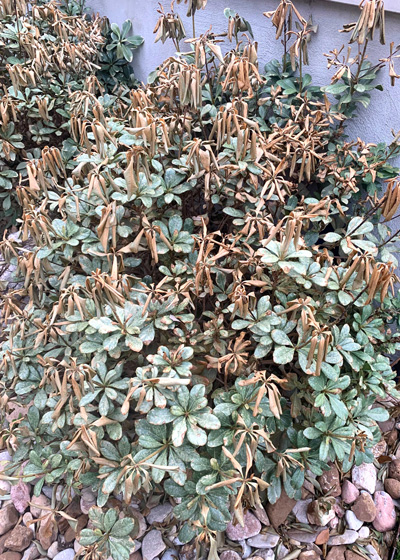
Answer: You can prune it lightly, but you’ll need to trim each branch individually (not with hedge trimmers). Pittosporums produce “candelabras” of new shoots. You’ll want to prune back to one of those clusters in a way that you’re not removing all of the branches and leaving unsightly stubs. Pittosporums will normally tolerate temperatures into the low 20s, but that’s if they’re exposed to progressively lower temperatures in the weeks before any really cold weather. This year’s first cold spell caught them before they had a chance to “acclimate.”
QUESTION 5
LIVE OAK SEEMS TO BE GOING DOWNHILL.
Question: Our 14-year-old live oak was hurt by the cold in February 2021. Our arborist trimmed out the damage in September 2021 and did a deep-root feeding and borer treatment. It seemed to be responding until December 2022 when we noticed bark splitting away and one branch with mold. What should we do? Shirley C., Justin, Denton Co.


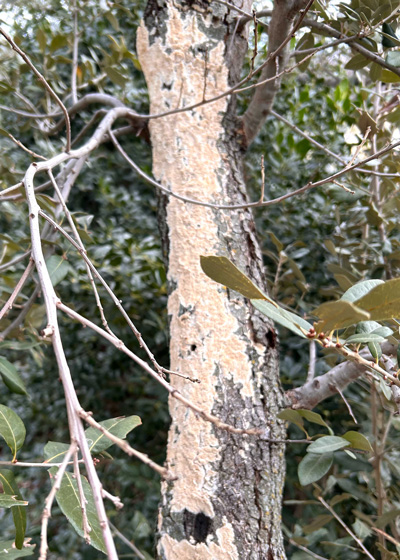
Answer: I’m very concerned about the long-term chances for your tree. That’s a significant amount of bark for it to have lost, plus the canopy looks very sparse. You will have a better idea by the time it gains its new leaves in March. The mold didn’t just happen in December. It has been developing for a long period of time, obscured most likely by the separated bark and by moisture trapped behind it. If the tree continues to decline you need to ask the arborist for an honest appraisal. You may want to have it taken out before it falls and does harm or causes injury.
QUESTION 6
WHAT IS WRONG WITH MY NELLIE R. STEVENS HOLLIES?
Question: I have several Nellie R. Stevens hollies that are on a drip irrigation system within a rock garden in full sun. They look like something has eaten on them. They aren’t as healthy as my others. What might be wrong? Randa L., Austin.
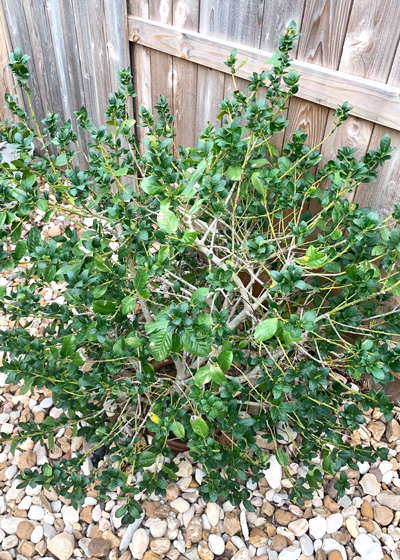
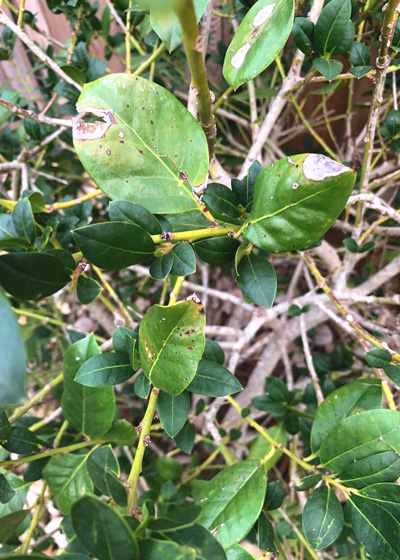
Answer: If I had to guess (which I suppose I am), I would say that your plant hasn’t gotten enough water. I see so many hollies that struggle with drip irrigation systems, especially in their first 2-3 years. To get water clear to the bottoms of the soil balls the systems have to be left running much longer than many folks realize. I would try to water more deeply and probably more often. Better yet, I’d use a hose with a water breaker or water bubbler at the end. I’d also apply an all-nitrogen, high-quality lawn food around the first of March to give them a boost into the spring.
QUESTION 7
IS IT WORTH PLANTING TULIP BULBS THAT HAVE BEEN CHILLING UNTIL NOW?
Question: I had my tulips in the garage refrigerator pre-chilling, planning to plant them in late December. What I hadn’t planned on was COVID. Should I just toss them and try again next year? Phyllis S., Dallas.
Answer: You know that they’ll be a loss if you do that. You could take a gamble and plant them into a concentrated area of a flowerbed or perhaps a large patio pot and give them a chance. All you have to lose is a little time and effort. They might surprise you. Your hope would be for a cooler February than normal. Before you do that, however, squeeze them to be sure they’re still plump. If they’re dried and flaky they’re not worth planting.
QUESTION 8
HOW CAN I GROW VEGETABLES WHEN THE NEIGHBOR’S TREES’ ROOTS GET INTO THE RAISED BEDS?
Question: My neighbor’s trees’ roots love the raised beds of my vegetable garden. I can’t move the garden because it’s the only sunny spot, and I can’t kill the roots because it’s not my tree. What can I do? Lisa B., Mansfield.
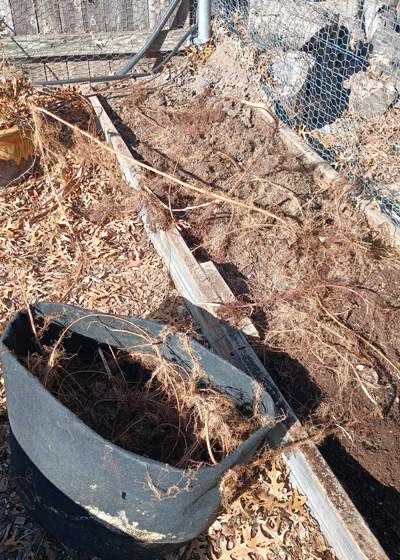

Answer: Somehow dig a trench right along the property line so that you can install a root barrier such as fiberglass sheets extending 16 inches into the soil. You could also use vinyl pond liner. You might even be able to put a weed-blocking fabric 12 to 15 inches deep to line the bottom of your garden. None of that is going to be easy work, but it all should be a big help. You do it once and hopefully you won’t have to do it again.
QUESTION 9
WHEN IS THE EARLIEST TIME I SHOULD TREAT FOR CHINCH BUGS AND SHOULD I ALTERNATE PRODUCTS?
Question: I want to get ahead on chinch bugs this year. When is the earliest I can treat for them? Do I need to alternate products? Jack K., Brazos Co.
Answer: You don’t “prevent” chinch bugs. You “stop” them as soon as you see the first signs of their invasion. They will return to the same parts of your lawn each summer (hottest, sunniest areas), and when they begin the grass will appear to be dry. However, when you irrigate, it won’t spring back with that normal bright green look. If you treat then, before any of the grass begins to turn yellow or tan, you’ll be able to keep ahead of their damage. One treatment per season should be enough, and you shouldn’t have to alternate from year to year.
QUESTION 10
HOW OFTEN SHOULD WE BE WATERING IN WINTER?
Question: How often should we be watering in winter? With these 80-degree days in the past week, it seems like it would be necessary. Pamela B., Southlake.
Answer: If it doesn’t rain in winter I normally water every couple of weeks. That will keep my plants’ root systems alive and well. But that timing will vary greatly depending on temperature, wind and rainfall. There is no set interval. I always check the soil before I water.
